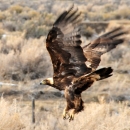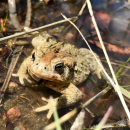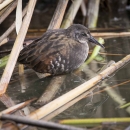About Us
Hutton Lake National Wildlife Refuge was established on January 28, 1932, by Executive Order. Consisting of 1,928 acres, the refuge is located approximately 10 miles southwest of Laramie. The refuge include Hutton Lake, Rush Lake, Creighton Lake, and Lake George. Mallards, redheads, teal, pintails, great blue herons, black crowned night-herons, phalaropes, western grebes, bitterns, and black terns use the refuge during fall and spring migrations. We manage Lake George and Creighton, Hutton, Hoge, and Rush lakes with the focus of migratory bird habitat for migration stopover and breeding habitat. Water management is opportunistic due to limited water rights and a closed basin system. Ponds are filled in the spring with natural runoff and maintained as high as possible over the birds’ breeding and brood-rearing seasons (June–August).
Our Mission
The mission of the National Wildlife Refuge System is to administer a national network of lands and waters for the conservation, management and, where appropriate, restoration of the fish, wildlife and plant resources and their habitats within the United States for the benefit of present and future generations of Americans.
Our History
In the early 1930's, J. Clark Salyer III was charged with identifying areas to protect as national wildlife refuges for migratory birds. Hutton Lake National Wildlife Refuge was one of two locations he chose after surveying the land surrounding Laramie, Wyoming and as a result the refuge was established by Executive Order 5782 on January 28,1932. Originally, 153 acres were withdrawn from the public domain for the establishment of this refuge in 1932. Additional lands were purchased with Migratory Bird funds in 1933 and 1939. In 1940, 147 acres were exchanged with a neighboring private landowner, which completed the refuge to it's current size.
During the 1960's, the headquarters for the Laramie Plains refuges was located in the Wyoming Farm Bureau office in Laramie, Wyoming. Upon the 1967 establishment of the Arapaho National Wildlife Refuge in Walden, Colorado; headquarters was moved to Arapaho National Wildlife Refuge in Walden, Colorado and the Laramie Plains refuges have been managed as part of the Arapaho National Wildlife Refuge Complex since 1967.
Other Facilities in this Complex
Hutton Lake National Wildlife Refuge is managed as part of the Central Sage Steppe Conservation Complex. A Conservation Complex is a group of two or more refuges, wildlife management areas, wetland management districts, or conservation areas that are primarily managed from a central office location. Refuges are grouped into a complex because they occur in a similar region, such as a watershed or specific habitat type, and have a related purpose and management needs. Typically, a project leader oversees the management of the refuges within the complex and refuge managers are responsible for operations at specific refuges. Support staff: administrative, law enforcement, refuge manager, biological, fire, visitor services, and maintenance, are centrally located and help with all refuges within the complex.
Other refuges in the Central Sage Steppe Conservation Complex include: Arapaho National Wildlife Refuge (Walden, Colorado); Pathfinder National Wildlife Refuge (Alcova, Wyoming); Bamforth National Wildlife Refuge, Mortenson Lake National Wildlife Refuge, and the Wyoming Toad Conservation Area (Laramie, Wyoming); as well as Seedskadee National Wildlife Refuge (Green River, Wyoming), Cokeville Meadows National Wildlife Refuge (Cokeville, Wyoming), and Wyoming's portion of the Bear River Watershed Conservation Area. Administrative headquarters for Arapaho, Pathfinder, and the Laramie Plains refuges is located at Arapaho National Wildlife Refuge, in Walden, Colorado phone number 970-732-8202, while administrative headquarters for the southwestern Wyoming refuges is located at Seedskadee National Wildlife Refuge, 37 miles north of Green River on Hwy 372 - 246 Seedskadee Road, PO Box 700, Green River, WY 82935; phone number 307-875-2187.







